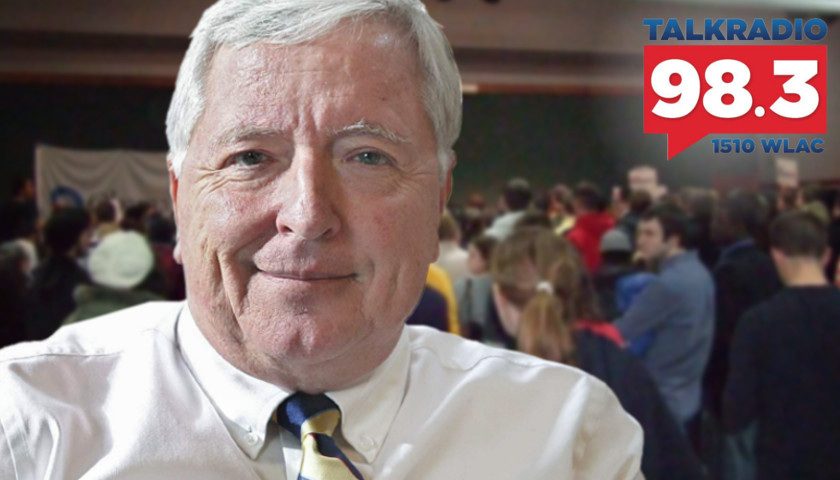Live from music row Monday morning on The Tennessee Star Report with Michael Patrick Leahy – broadcast on Nashville’s Talk Radio 98.3 and 1510 WLAC weekdays from 5:00 a.m. to 8:00 a.m. – Leahy was joined on the newsmakers line by longtime friend and ambassador to Iowa Democratic presidential field, Jim Larew.
During the second hour, Larew weighed in on the current Anne Seltzer poll showing Sanders back in the lead and how that compared to what he was seeing in real-time on the ground. He added that he was seeing a strong commitment from Sanders supporters and that Buttigieg’s downward trajectory is likened to his latest views on foreign policy and young age.
Leahy: I am joined now by my very good friend and a big attorney in Iowa, former chief of staff and general counsel to Governor Chet Culver of Iowa. A Democrat. And our ambassador to the Democratic field. My guide when I was up there back in November, Jim Larew. Good morning Jim.
Larew: Good morning Michael.
Leahy: Well, a new poll. Three weeks Jim! Three weeks!
Larew: Almost there.
Leahy: Almost there.
Larew: That’s right. It’s getting close.
Leahy: Do you know where you will caucus and where your caucus will be held? The one that you were telling me about.
Larew: Our caucus will be held where Iowa city precinct four. Too many people to fit into our Lincoln Elementary school gym where we’ve congregated for nearly 50 years. We’re going to be in a large university gymnasium type building 600 or something like that.
Leahy: Wow. Big crowd. So you will be there, right?
Larew: Yes.
Leahy: And the poll came out three days ago, Iowa Des Moines Register. The woman who ran it you say she is the best pollster in Iowa. Anne Seltzer is that her name?
Larew: Ann Seltzer as the gold standard. Ann Seltzer over the past cycle has established herself as the gold standard because she uses a methodology that others do not and it has proven to be very accurate in the past. We’ll see how it does this time.
But basically unlike many actuarial predictions of who try to make mathematical actuarial predictions as to who will participate and then ask those people how they’re going to vote. She just starts out the interview with, are you going to caucus or not?
Leahy: Yeah, pretty simple.
Larew: Then they hang up and go to the next. Pretty simple and pretty accurate. Whatever she says people listen to carefully. And her results are not far off from the others but there are nuances that she picks up as usual on that others but there are nuances that do not and it gives us something to talk about.
Leahy: So this poll is of 701 Democratic voters has a margin of error plus or minus 3.8%. Having said that, it’s got a top-four that the leader in this poll is again, within the margin of error is Bernie Sanders. That’s the first time he’s been leading. That’s news of sorts. He’s at 20%. Elizabeth Warren at 17%.
Pete Buttigieg at 16%. And then, Joe Biden at 15%. And then Klobuchar, Yang, and the rest of the gang below that. I got a suggestion for you. It does suggest some momentum for Bernie and a decline of momentum for Pete Buttigieg. Is that what you’re seeing on the ground, Jim?
Larew: Yes, I think so. It feels real and a couple of things there that really distinguishes their candidacies. I think Buttigieg may be had the misfortune to have peaked at a time when a large number of people were really quite undecided. He was at his apex was when people were the most fluid.
By comparison, Sanders I would call it less of candidacy and more of a movement. The people that are with Sanders stay there when he had heart problems. They didn’t move. And he had a floor which is higher than any other candidacy and it’s a strong organization. And you can feel that.
His rallies are large that people are staying with him and he has the largest percentage this poll says. His people’s minds are made up. They are the most enthusiastic. Those are really good benchmarks for a caucus which really is different than a primary.
And he’s in I think a pretty good position. Buttigieg, may or may not be. His footprint this poll says if you take fist choice, the second choice, and are considering, his footprint seems to be the largest of all the four front runners. But his trajectory is a downward position and that has to alert him.
Leahy: Has he made a mistake? Why is that?
Larew: My interpretation is, the poll doesn’t say this. I think the events of the last several weeks on foreign affairs, although he has genuine military experience which distinguishes him from other candidates and even the President, at the same time he’s such a young person.
Leahy: Yeah.
Larew: I think that there are things that voters in Iowa are older. Participants in the caucuses are older on average than the Iowa voter and they know that some wisdom comes with age. And I think that is probably weighing down a little bit with him. Also, when he spurted ahead a couple of months ago he became the center of attack from all the other candidates in a predictable way until his negative increased somewhat.
Leahy: Interesting.
Larew: That trajectory is downward. Let’s go back to your first point Michael that I thought was important with the margin of error was really less than or equal to five points between the top and the bottom candidate. You could conclude that the poll does not statistically and significantly (Inaudible talk)
Leahy: Right. It’s a four-way tie if you look at that.
Larew: That’s right. That’s not an unimportant thing to say.
(Commerical break)
Leahy: You were talking about 1988 and how you see some comparisons between ’88 and today.
Larew: We had a large field in ’88 and at that time there were five candidates that were comparable period in the campaign who had 10% or more percentage points in polls. it allowed someone like Michael Dukakis to come really out of nowhere and come into the lead and move forward and capture some position in the caucuses and then go on to get the nomination.
We’ve never had in 50 years of caucusing four top contenders that have more than 15%. And what that means I’m not sure. It makes it I think very fluid. 1 or 2. All of these four can claim some kind of victory if it stays this close coming out of Iowa win. but at the very least it makes it more difficult to predict now what will happen in three weeks when we have the caucus.
Leahy: Now just for our listeners. How many caucuses are around the state?
Larew: Exactly. A little over 1600 traditionally. But they’ve opened up a concept satellite caucuses. There has been criticism that some people can’t make it to some places so it’s predicted there could be up to numbers not known.
Leahy: And the way it works is you all show up. So at your caucus, you’re going to attend has 600 people in the room.
Larew: Right.
Leahy: And the first thing you do is you all get into a group. Here’s the Bernie Sanders corner. Here’s the Elizabeth Warren corner. Here’s the Pete Buttigieg corner. And then they count up. And what happens is I guess is if a candidate doesn’t have 15% of the support of those attending those people have to go find another candidate right?
Larew: They do or they can go to a group called ‘uncommitted’ but that must have 15% to remain viable as well. One new thing that’s going on this year Michael is that before there have been criticisms that when all this is said and done and people at the end of the line people have gotten into their delegate groups and the delegate count were choosing delegates for a President in their party. But the people have argued that it distorts it. You don’t really know what the initial breakdown was. So they are going to do what they call a raw vote total.
Leahy: For the first round?
Larew: The first round. And that will be a number that is out there. And people who do better in that then the delegate count will point to that and brag about it. That’s the delegate count ultimately.
Leahy: That’s a Klobuchar relief plan right? Here’s what it looks like to me. You tell me. So there are 1600 of these caucuses and if every caucus were to be like the poll, but probably wouldn’t be but there would be some variation. So you start off and you’ve got four candidates that start out with plenty. And between them, they have like 75% and they’re all over 15%.
That’s Sanders, Warren, Buttigieg, and Biden. Then there’s the rest of the candidates, with all these Klobuchar, Yang and Booker and they’ve got to go somewhere right? So isn’t this all about whether Bernie or Elizabeth of Pete or Joe can attract those other supporters? Is that what plays out?
Larew: It does. And in candidacies that are less well organized, it will be just ad hoc. Whoever shows up at night will be trying to direct. If they’re well organized I can imagine there are some winks and nods going on with the major candidates than these lesser ones.
The look of, you would be a very good vice presidential candidate or something like that. So if you’re well organized you can bring your whole group. That’s a lot of territory to cover over 17 caucuses and I doubt that the Klobuchar’s, Yang’s, and others would be organized to direct that kind of movement.
Listen to the second hour:
– – –
Tune in weekdays from 5:00 – 8:00 am to the Tennessee Star Report with Michael Patrick Leahy on Talk Radio 98.3 FM WLAC 1510. Listen online at iHeart Radio.





